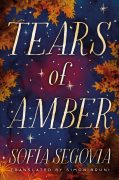TEARS OF AMBER by Sofía Segovia
 When Mexican literary star Sofía Segovia’s Spanish language novel, El murmullo de las Abejas, was translated and published in English in 2019, The Washington Post praised Segovia as “a writer whose absorbing yet accessible prose and gift for sprinkling the mystical into a deeply human narrative is sure to draw comparisons to Latin American greats, such as Isabel Allende.”
When Mexican literary star Sofía Segovia’s Spanish language novel, El murmullo de las Abejas, was translated and published in English in 2019, The Washington Post praised Segovia as “a writer whose absorbing yet accessible prose and gift for sprinkling the mystical into a deeply human narrative is sure to draw comparisons to Latin American greats, such as Isabel Allende.”
On May 1, 2021, Sofía Segovia’s achingly beautiful page-turner Peregrinos is published in English for the first time by Amazon Crossing as TEARS OF AMBER, expertly translated by Simon Bruni, who also brought THE MURMUR OF BEES to an English-reading audience.
In TEARS OF AMBER, two families from different regions of Prussia flee their villages in an exodus provoked by the horrors of World War II. Hope carries Ilse Hahlbrock and Arno Schipper, children caught in the crosshairs of war, on an extraordinary pilgrimage in which the gift of an amber teardrop is at once a valuable form of currency and a symbol of resilience, one that draws them together against insurmountable odds.
Influenced by real events, TEARS OF AMBER is a Prussian story, but it is also a Mexican story. In an interview with Publishers Weekly, Segovia shares her inspiration:
“The protagonists settled in my hometown and I am a close friend of one of their daughters, born in Germany. I had never dared to ask what had been of her parents’ during the war, because I knew it had to be a difficult subject. But when she told me about her mother as a little girl in a runaway carriage, holding her brother tight, I was hooked by the images. Then by the amazing, almost-impossible-to-believe coincidences that brought her father and mother together, both alive, not only in body but also in spirit, in hope.
Their story lives in them and in their children just a few blocks from my home. They created an amazing, generous, loving Mexican-German family. They are German, but they break the stereotype of the movies and novels: they were not soldiers, they were little kids with hopes and dreams in Prussia when this war, abandonment and exodus happened to them. I wanted to break with the usual way we know WWII. It was a risk I took, looking out of the eyes of German folk and not from those of the usual victims. But I realized that the truth of the despicable Holocaust and the truth of children and families like those in TEARS OF AMBER coexisted and even complement and completed each other. So I wrote it.”
First published in Mexico in 2018, Peregrinos (TEARS OF AMBER) received widespread acclaim from the international press. Hojeando / El Norte cheered, “Peregrinos is the best novel so far this year and its author is in a time of undoubted maturity.” Tote Cabana calls it “A story to read slowly, with phrases that bristle and reach deep inside.…[Peregrinos] does not refer to the life of those who organize war, nor to those who benefit from it, it tells of the life of the common citizen, the innocent, the boy, the girl, the wife, the father, the neighbor.”
And El Librero de Valentina hails the book as “One of my favorite novels of the year! A story that is as shocking as it is moving, in which courage, resilience and love fill us with hope.”
We are delighted to feature this except of TEARS OF AMBER
translated by Simon Bruni
(Amazon Crossing; May 1, 2021)
 Satisfied with her efforts to cover up what she’d done, Ilse tied the ribbon as well as she could to the mutilated end of her braid, which she tried without much success to weave together again. She was unable to redo the bow, but it didn’t matter: her ribbons often ended the day as nothing more than knots, the strips hanging down. She undid her other braid’s bow, certain that, this way, her mother wouldn’t notice anything amiss. But she’d better make sure: she climbed onto the chair again to look at herself in the elegant oval mirror with its golden frame, which, like the scissors, her mother had positioned high above Ilse’s head.
Satisfied with her efforts to cover up what she’d done, Ilse tied the ribbon as well as she could to the mutilated end of her braid, which she tried without much success to weave together again. She was unable to redo the bow, but it didn’t matter: her ribbons often ended the day as nothing more than knots, the strips hanging down. She undid her other braid’s bow, certain that, this way, her mother wouldn’t notice anything amiss. But she’d better make sure: she climbed onto the chair again to look at herself in the elegant oval mirror with its golden frame, which, like the scissors, her mother had positioned high above Ilse’s head.
Had her face changed? No. She was the same girl she saw every day in the simple mirror in her parents’ room. A chestnut-haired girl with large amber-colored eyes, a pretty face (she knew it was pretty because her father told her so every day) even if, as always, it was a little less than clean: there was a dark streak on one cheek, though she hadn’t even been outside yet.
But something was different, because now Ilse was missing a sizable piece of her braid. Not even her ploy with the ribbons had worked. She lifted her shoulder in an attempt to shorten the distance between it and the braid but didn’t like what she saw: she looked like the old storekeeper Lutz’s son, the one with the bent back.
Then she turned to see the scissors where she’d left them: on the kitchen table. They were still as shiny, sharp, pointy, irresistible, and within her reach as before. What if she cut the other braid? Now she knew it didn’t hurt at all.
But at that moment, something distracted her from the lure of the scissors and the tragedy of her misshapen braid. Something she thought she’d never seen before: a brightness that came in through the window.
She ran to look out: the world outside shone in radiant colors, and like a fan slowly opening, the grays that had defined her whole life vanished before her eyes.
It was the sun.
The elusive sun that Ilse had forgotten was real, had come to believe existed only in her imagination. It was no longer the weak, timid celestial body that had persuaded her the sun was like the mythical Erdhenne, a spirit that children talked about without ever having seen it. Her mother had told her: There are no invisible spirits inside things. They are made up. And adults had to be believed.
But this sun was just like in the stories: bright, hot, inviting. This sun was real and unobstructed by a single cloud, and the colors were finally as they were meant to be and not the sad imitations that had been offered her until that day.
It wasn’t that Ilse had only lived during winter; this would be her fourth spring, her fourth summer. It was that she only remembered the last few months: an overcast life, freezing skin, the cold air that dried everything out, the snow that snuck in uninvited. And darkness. Most of all she remembered the darkness.
Six months in the life of a four-year-old child can be an eternity, and Ilse had ended up thinking the world would be the same forever; that daylight was fleeting and it was always cold, even at night, covered in a thick eiderdown.
She couldn’t remember what it meant to go out in the yard without her heavy overcoat, stockings, and hat; she couldn’t remember the feeling of short sleeves or of grass beneath bare feet.
Peering out through the window, Ilse forgot about braids long or short; she forgot about her doll; she forgot about the boredom. She even forgot about the seductive scissors, because now it was the sun that called to her.
Ilse dragged the chair over to the door and unlocked the bolt. Then she opened the door and stepped out into the bright light to surround herself with colors, to feel the heat on her skin. And because of the intense emotion she felt, this moment became the first permanent memory of her life.
Of course, the girl didn’t think, this is my first memory. That’s not how these things happen. But years later, when her only sweetheart asked, what’s your first memory? she’d reply that it was the sun, the warmth of the sun on her forehead despite the day’s freezing air. And with that memory came the memory of the colors. And her wild desire to run aimlessly after the clouds that were finally discrete and not one thick mass like flour-and-water paste in the sky.
By then, that day when Ilse went out to discover the sun’s colors, Germany had already seized the Polish Corridor with the lightning of its Blitzkrieg, and future historians would take the view that, in reclaiming the territory the world had given away to Poland, Germany triggered the chain of events that would ensue.
Triggered another world war: the second one.
But perhaps they were wrong: perhaps that war was predetermined, the actors already in position. Perhaps everything clicked into place with the pact between the Germans and Italians, or when Germany split the Polish territory with the Soviets. Perhaps everything began with the German invasion of the Sudetenland, or with the Anschluss; or earlier, with the creation of the Gestapo; or earlier still, with the recognition of Hitler as Führer and with the power he invested in his Brownshirts; or even before that, when he wrote Mein Kampf in jail; or with the destitution of Germany’s postwar period; or with the Treaty of Versailles; or with the first war, the one the world naively thought would end all wars.
Ilse herself wouldn’t be exempt from wondering when the tipping point had come. But not until years later. That day of her first sunlit memory, she had no notion of how that chain of events would affect her, how it would affect humanity.
And so, as a grown woman, she’d reply honestly to her sweetheart when he asked about the first memory of a German girl, who, like him, had been caught up in the merciless whirlwind of war, and tell him that her earliest memory was the sun. Then she’d go on: And I went to find Janusz.
Like the winter gloom, Ilse believed Janusz had been there forever. Like her, like everything she knew. She didn’t remember that her dear Janusz had arrived the last time the sun went away, arrived with the cold and the darkness after the Blitzkrieg, arrived as a prisoner in a military truck along with Józef, Radosz, and Tadeusz.
BUY HERE
Category: On Writing






























